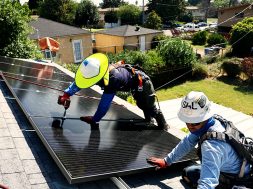
Uberising India’s Residential Rooftop Solar Market

By scaling up rooftop solar, Indian cities could generate their own electricity rather than sourcing it from coal power plants hundreds of kilometers away
India’s clean energy revolution has eluded households since it took off four years ago. This is in spite of the residential sector offering the maximum potential, close to 180 gigawatts (GW) of rooftop solar across the country. By scaling up rooftop solar, Indian cities could generate their own electricity rather than sourcing it from coal power plants hundreds of kilometers away. If the potential is realised, the electricity generated would be sufficient to meet 80 percent of India’s current household electricity demand. However, the rooftop sector has a meagre share of 3.5 GW (residential rooftop sector contributes only 0.5 GW), of the total 29.4 GW of solar installations deployed so far. How can we transform India’s residential rooftop solar market?
In recent years, India’s commercial and industrial sectors have witnessed the rising uptake of rooftop solar installations. One of the reasons for this is the adoption of the RESCO (Renewable Energy Service Company)-based model, wherein consumers can avail solar electricity at tariffs lower than the grid tariffs without any upfront capital expenditure. Rooftop solar developers have successfully implemented this model in high-rise buildings as well where citizens have welcomed low upfront costs. However, developers have not been able to scale up rooftop solar further, especially among communities living in low-rise buildings or individual houses. Their major concerns include the smaller installation size of rooftop solar systems for individual consumers and the associated high risk of a payment default. Another limitation of the RESCO model is the potential risk to bottom lines that declining solar power costs could cause. As the solar tariff declines, existing consumers could demand solar power at prevailing market rates. This could add to the uncertainty of the contract that already plagues the rooftop solar businesses.
One way to address these challenges and kickstart mass adoption of rooftop solar would be by embracing a new business model that could make solar power affordable and accessible to all residential consumers. Recently, the Council on Energy, Environment, and Water (CEEW), in partnership with BSES Yamuna (BYPL), developed a ‘solar partners’ model, on lines of the demand and supply aggregation model of ride-on-demand services like Uber. There are three main components in Uber’s model: demand and supply aggregator (Uber), car owners, and consumers (riders). In the solar partners model, the discom plays the role of the aggregator by creating a platform for residential consumers to subscribe to solar electricity. Solar companies would own the solar electricity generating asset, a rooftop solar PV system, and sign a power purchase agreement with the discom. The discom would facilitate payments from residential consumers to solar companies after deducting a facilitation fee, an additional source of revenue.
Residents would benefit by availing solar electricity directly from the discom without installing a rooftop solar system on their premises. This would be similar to taking an Uber ride to a destination without owning a car. This model would make rooftop solar accessible to all residential consumers, including those living in rented properties, by eliminating the need to have exclusive roof access to generate solar power. Further, on-ground research by CEEW revealed consumer willingness to adopt this model. Out of the 420 residential households surveyed by CEEW in the BYPL license area, as many as 80 percent households that did not have suitable roof space, expressed willingness to avail solar electricity under the solar partners model.
The model could potentially open up the residential market by eliminating two major risks faced by rooftop solar developers. First, the uncertainty over the sanctity of contracts would be eliminated due to the two-part structuring of the contracts. In the solar partners model, tariffs from the capacity that are auctioned off periodically are bundled so that the consumers pay the annual average cost of generation each year instead of a fixed rate for 25 years. Any decline in market price would be well-reflected in the yearly tariff.
Second, the risk posed by solar tariffs being higher than grid tariffs for consumers receiving electricity subsidies. This model has the flexibility to offer affordable slab-based solar tariffs to consumers in different consumption slabs. This could ensure competitive solar tariffs even to highly subsidised consumers. As per CEEW analysis, such a subscription programme with up to 5 percent of the capacity reserved for low-paying segments can generate 25-30 per cent savings on electricity expenses for all the participating consumers over the system’s lifetime.
Even though new business models such as solar partners offer vast potential, on-ground success will be dependent on effective implementation of new regulatory provisions such as virtual net-metering, support from discoms, and active citizen participation. In the long run, residential consumers could yet become central to driving India’s clean energy transition.
Disclaimer: The views expressed in the article above are those of the authors’ and do not necessarily represent or reflect the views of this publishing house. Unless otherwise noted, the author is writing in his/her personal capacity. They are not intended and should not be thought to represent official ideas, attitudes, or policies of any agency or institution.
















